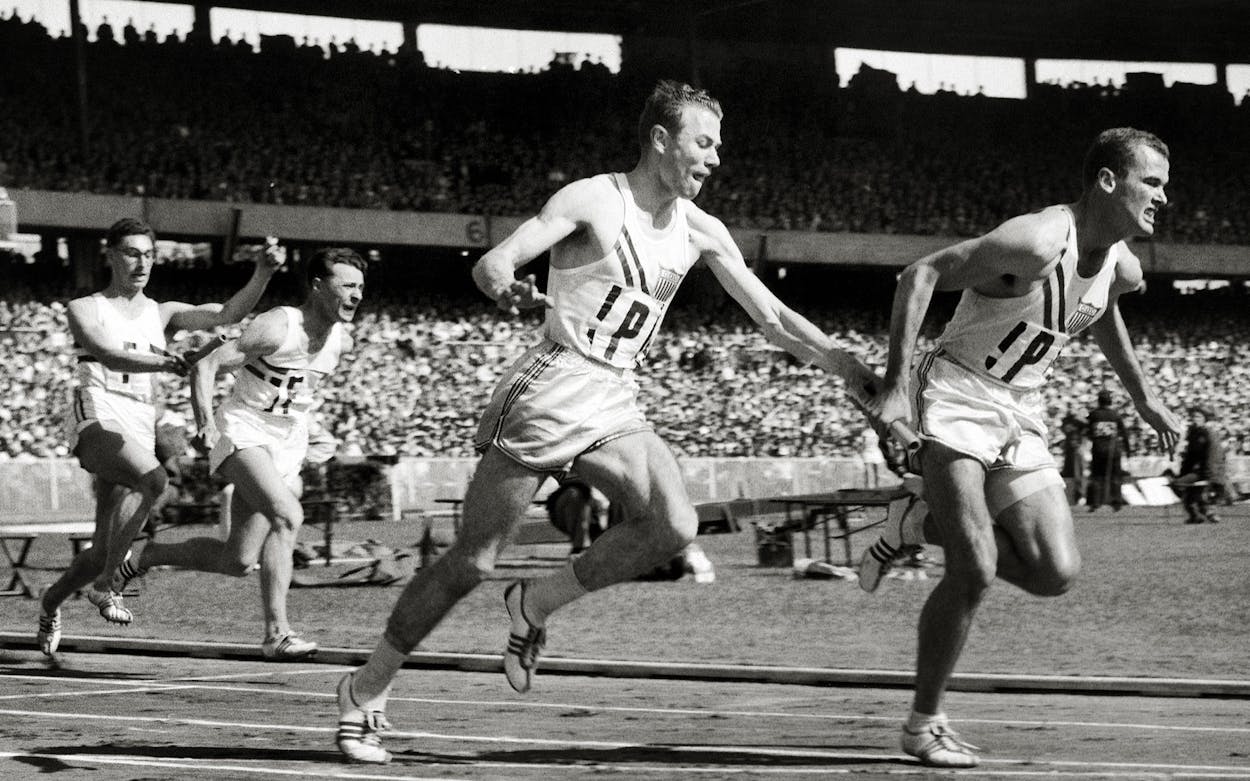When it came time for me to choose a college in the mid-sixties, Abilene Christian College was at the top of my list. We were a Church of Christ family, and my cousin had been a track and football star at ACC (now ACU) a few years ahead of me. Those were the primary reasons, but there was one more: a decade earlier, the fastest man in the world had put the obscure West Texas church school on the map. When I told people where I was going, his name invariably came up. I liked that.
Bobby Morrow, the dominant sprinter of his era, died at his home in Harlingen on May 30. At 84, he was decades beyond the Olympic gold medals; the Life magazine and Sports Illustrated covers featuring his handsome, clean-cut face; the appearances on the Ed Sullivan and Arthur Godfrey shows; and the black and white newsreels of scintillating track triumphs at the Melbourne Olympics in 1956. At his death, few remembered who he had been more than six decades earlier. He had become, as the Guardian described him a few years ago, “a champion lost to history.”
He was born Bobby Joe Morrow on October 15, 1935, in Rangerville, a Rio Grande Valley village near San Benito. He was a farm boy who, legend has it, chased down rabbits in the field before winning races on the track. On his family’s six-hundred-acre cotton and carrot farm, he drove a tractor long before he drove a car.
At San Benito High School, Morrow excelled as a halfback for the aptly named Greyhounds and on the track, where he was a three-time state champion sprinter. Coaches from all the Southwest Conference schools and elsewhere around the country watched him run in Austin at the 1954 state track meet. Declining their scholarship offers, he enrolled at Abilene Christian, in part because his older brother and cousins were studying there, but mainly because of Oliver Jackson, the college’s track coach. The young coach was molding a perennial track-and-field powerhouse at the little West Texas school. He would go on to mentor four Olympic champions.
“Bobby had poise and a fluid motion like nothing I’ve ever seen,” Jackson told Sports Illustrated. “He could run a 220 with a root beer float on his head and never spill a drop. I made an adjustment to his start when he was a freshman. After that, my only advice to him was to change his major to speech because he’d be destined to make a bunch of them.”
Bill Martin, a sociology professor emeritus at Rice University, was an ACC classmate. “The first time I saw him run, my eyes—quite to my surprise—filled with tears,” he wrote in a 1984 Texas Monthly profile. “As he rocketed through the curve and down the stretch, extending a string of victories that would mark him as the finest sprinter since Jesse Owens, perhaps the best the world had ever seen, Bobby Morrow was as beautiful as a high-speed human could be.”
As a freshman, Morrow won the 1955 Amateur Athletic Union (AAU) championship in the 100-yard dash, and a year later won the 100 and 200 meters at the NCAA championships.
On the Olympic track at the Melbourne Cricket Ground, he won gold in the 100 meters with an official time of 10.5 seconds, then matched the world record of 20.6 seconds in the 200 meters. A few days later he anchored the U.S. team on the 4-by-100 relay, helping set a world record of 39.5 seconds. The Americans broke the mark that Owens, on hand to watch, had helped set at the 1936 Olympics in Berlin.
The triple gold medalist came home a hero. He received the Sullivan Award, honoring the outstanding amateur athlete of the year. Sport Magazine named him Athlete of the Year. He was Sports Illustrated’s Sportsman of the Year, eclipsing Green Bay Packers football star Paul Hornung, baseball’s Triple Crown hitter Mickey Mantle, and New York Yankees hurler Don Larsen, who had pitched the only perfect game in World Series history. Morrow addressed the Texas Legislature, took part in a White House conference with President Eisenhower, and was named one of nine greatest living Americans by the U.S. Chamber of Commerce.
Alas, fame was fleeting. He failed to qualify for the 1960 Rome Olympics and retired from running. His first marriage ended, and he got involved in a couple of sketchy business ventures. Morrow grew disillusioned with Abilene Christian, feeling he had been exploited (although he and the school eventually reconciled). He drifted back to San Benito and eventually back to farming. Occasionally he made public appearances or motivational speeches, but mainly he lived a quiet life. “You would never know he had three Olympic gold medals in his pocket unless someone else told you,” said Garner Roberts, a retired sports information director at ACU.
“He really didn’t see his gifts as anything special,” his daughter Elizabeth Kelton told the Washington Post. “He always said: ‘It’s not like I cured cancer. I just ran.’”






